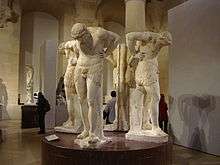Navel gazing
Navel-gazing or omphaloskepsis is the contemplation of one's navel as an aid to meditation.[1]

The word derives from the Ancient Greek words ὀμφᾰλός (omphalós, lit. 'navel') and σκέψῐς (sképsis, lit. 'viewing, examination, speculation').[1]
Actual use of the practice as an aid to contemplation of basic principles of the cosmos and human nature is found in the practice of yoga or Hinduism and sometimes in the Eastern Orthodox Church.[2] In yoga, the navel is the site of the manipura (also called nabhi) chakra, which yogis consider "a powerful chakra of the body".[3][4] The monks of Mount Athos, Greece, were described as Omphalopsychians by J.G. Minningen, writing in the 1830s, who says they "...pretended or fancied that they experienced celestial joys when gazing on their umbilical region, in converse with the Deity".[5]
However, phrases such as "contemplating one's navel" or "navel-gazing" are frequently used, usually in jocular fashion, to refer to self-absorbed pursuits.[6]
References
- "omphaloskepsis". Merriam-Webster Dictionary. Retrieved 2013-06-22.
- Becker, Udo (2000). The Continuum Encyclopedia of Symbols. Continuum International. p. 210. ISBN 978-0-8264-1221-8.
- Craig, Royal L. (2010). Whispers beyond the Edge. Xlibris. p. 99. ISBN 978-1-4500-7972-3.
- Norbu, Chogyal Namkhai (2008). Yantra Yoga. Snow Lion. p. 15. ISBN 978-1-55939-308-9.
- Millingen, J.G. (1839). Curiosities of Medical Experience (2nd ed.). London: Richard Bentley. p. 40. Retrieved 2 March 2018.
- Lyn, E.R. (2009). Abbreviations Acronyms Glossary for American Readers. CreateSpace. p. 490. ISBN 978-1403360496.